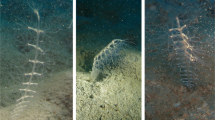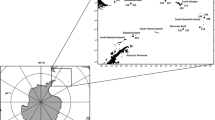Abstract
Sarsia medelae sp. nov. is described and illustrated from material collected in the Weddell Sea during the R/V Polarstern cruises ANT XVII/3 (April 2000) and in the Ross Sea during the R/V Italica cruise XIX (March 2004). The specimens have always been observed in association with several gorgonians of genera Thouarella sp., Primnoisis sp., and Notisis sp. The polyps of Sarsia medelae are considered as mesobiont of the gorgonian host with a non-parasitic relationship. It is the first time that this kind of association, which is so far only known from the Indian and Pacific Ocean, is reported in the Southern Ocean. This finding is discussed in the framework of the hypothesis that a part of Antarctic fauna has its origin in species dating back to before the Cretaceous period, because this kind of association between a hydroid and a gorgonian host being only known in the actual Antarctic shelf and in regions belonging to the previous Thethys areas.



Similar content being viewed by others
References
Alderslade P (1998) Revisionary systematics in the gorgonian family Isididae, with descriptions of numerous new taxa (Coelenterata: Octocorallia). Rec W Aust Mus Suppl 55: 1–359
Allman GJ (1883) Report on the Hydroida dredged by H.M.S. Challenger during the years 1873–1876. Rep Sci Res Challenger Exp (Zool Ser) 7:1–55
Arntz WE, Brey T, Gallardo VA (1994) Antarctic zoobenthos. Oceanogr Mar Biol Ann Rev 32:241–304
Arntz WE, Gutt J, Klages M, (1997) Antarctic marine biodiversity: an overview. In: Battaglia B, Valencia J, Walton DWH (eds) Antarctic communities, species, structure and survival. Cambridge University Press, Cambridge, pp 3–14
Bayer FM (1981) Key to the genera of Octocorallia exclusive of Pennatulacea (Coelenterata: Anthozoa), with diagnoses of new taxa. Proc Biol Soc Wash 94: 902–947
Billard AE (1919) Note sur une espèce nouvelle d’Hydroïde Gymnoblastique (Clava krempfi) parasite d’un Alcyonaire. Bull Mus Nat Hist 3: 187–188
Boero F, Bouillon J, Gravier-Bonnet N (1995) The life cycle of Pteroclava krempfi (Cnidaria, Hydrozoa, Cladocorynidae), with notes on Asyncoryne philippina (Asyncorynidae). Sci Mar 59: 65–76
Boero F, Bouillon J, Gravier-Bonnet N (2000) A survey of Zanclea, Halocoryne and Zanclella (Cnidaria, Hydrozoa, Anthomedusae, Zancleidae) with description of new species. Ital J Zool 67: 93–124
Bouillon J (1967) Révision de la famille des Ptilocodiidae avec la description d’un nouveau genre et d’une nouvelle espèce. Bull Acad R Med Bel 53: 1106–1131
Bouillon J (1985) Essai de classification des Hydropolypes-Hydroméduses (Hydrozoa-Cnidaria). Indo-Malayan Zool 2: 29–243
Bouillon J (1995) Classe des Hydrozoaires. In: Grassé PP, Doumenc D (eds) Traité de Zoologie 3 (2), Masson, Paris pp 29–416
Browne ET (1902) A preliminary report on Hydromedusae from the Falkland Islands. Ann Mag Nat Hist 9:272–284
Clarke A, Crame JA (1989) The origin of the Southern Ocean marine fauna. In: Carme JA (ed) Origins and evolution of the Antarctic Biota, Special Publication 47. Geological Society, pp 253–268
Clarke A, Crame JA (1992) The Southern Ocean benthic fauna and climate change: a historical perspective. Philos Trans Roy Soc Lond B 338: 299–309
Clarke A, Johnston NM (2003) Antarctic marine benthic diversity. Oceanogr Mar Biol Annu Rev 41: 47–114
Clarke A, Aronson RB, Crame JA, Gili JM, Blake DB (2004) Evolution and diversity of the benthic fauna of the Southern Ocean continental shelf. Antarct Sci 16: 559–568
Coward WE (1909) On Ptilocodium repens, a new gymnoblastic hydroid epizoic on a Pennatulid. J Ultrastruct Res 72: 13–19
Crame JA (1994) Evolutionary history of Antarctica. In: Hempel G (eds) Antarctic science. Springer, Berlin Heidelberg New York, pp 188–214
De Bary A (1879) Die Erscheinung der Symbiose. Strassburg: Verlag Von Karl J. Trubner
De Broyer C, Jazdzewski K (1993) Contribution to the marine biodiversity inventory. A checklist of the Amphipoda (Crustacea) of the Southern Ocean. Brussels
Gili JM, Hughes RG (1995) The ecology of marine benthic hydroids. Oceanogr Mar Biol Ann Rev 33:351–426
Gotto RV (1969) Marine animals. Partnerships and other associations. The English University Press, London, pp 1–96
Goy J (1995) Ecologie des Hydrozoaires. In: Grassé PP, Doumenc D (eds) Traité de Zoologie 3(2), Masson, Paris, pp 473–521
Hirohito (1988) The hydroids of Sagami Bay. (part I. Athecata). Publications of the Biolological Laboratory, Imperial Household, Tokyo, pp 1–179
Knox GA, Lowry JK (1977) A comparison between the benthos of the Southern Ocean and the North Polar Ocean with special reference to the Amphipoda and the Polychaeta. In: Dunbar MJ (ed) Polar oceans. Arctic Institute of North America, Calgary, pp 423–462
Kramp PL (1959) The Hydromedusae of the Atlantic Ocean and adjacent waters. Dana-Rep 46: 1–283
Kramp PL (1961) Synopsis of the medusae of the world. J mar biol Ass UK 40: 1–469
Lincoln R, Boxshall G, Clark P (1998) A dictionary of ecology, evolution and systematics, 2nd edn. Cambridge University of Press, Cambridge
Lipps JH, Hickman CS (1982) Origin, age and evolution of Antarctic and deep-sea faunas. In: Ernst WG, WG JG, Morin JG (eds) The environment of the deep sea. Prentice Hall, Englewood Cliffs, pp 325–356
López-González PJ, Gili JM (2005) Two new dimorphic soft-coral species (Anthozoa: Octocorallia). Hydrobiologia (in press)
López-González PJ, Williams G (2002) A new genus and species of sea pen (Octocorallia: Pennatulacea: Stachyptilidae) from the Antarctic Peninsula. Invert Syst 16: 919–929
López-González P, Gili JM, Orejas C (2002) A new primnoid genus (Anthozoa: Octocorallia) from the Southern Ocean. Sci Mar 66: 383–397
Marchenkov AV (2001a) The peculiarities of parasitism in the copepoda and rhizocephala. Parazitologiia 35: 89–97
Marchenkov AV (2001b) Some peculiarities of the relationships between parasitic copepods and their invertebrate hosts. Parazitologiia 35:406–428
Millard NAH (1977) Hydroids from the Kerguelen and Crozet shelves, collected by the cruise MD.03 of the Marion-Dufresne. Ann S Afr Mus 73: 1–47
Millard NAH (1978) The geographical distribution of Southern African hydroids. Ann S Afr Mus 74: 159–200
Millard NAH, Bouillon J (1973) Hydroids from the Seychelles (Coelenterata). Ann Mus Roy Afr Cen 206: 1–106
Paracer S, Ahmadjian V (2000) Symbiosis. An introduction to biological associations. Oxford University Press, Oxford
Peña Cantero AL, Svoboda A, Vervoort W (1997a) Species of Staurotheca Allman, 1888 (Cnidaria: Hydrozoa) from recent antarctic expeditions with R. V. Polarstern, with the description of six new species. J Nat Hist 31: 329–381
Peña Cantero AL, Svoboda A, Vervoort W (1997b) Species of Oswaldella Stechow, 1919 (Cnidaria: Hydrozoa) from recent antarctic expeditions with R.V. Polastern, with the description of eight new species. Zool J Linn Soc 119:339–388
Piraino S (1992) The stinging egg of Clavopsella michaeli (Berrill) (Hydrozoa, Cnidaria). Boll Zool 59:251–256
Piraino S, Bouillon J, Boero F (1992) Halocoryne epizoica (Cnidaria, Hydrozoa), a hydroid that ‘bites’. Sci Mar 56:141–147
Schuchert P (1996) The marine fauna of New Zealand: Athecate hydroids and their medusae (Cnidaria: Hydrozoa). N Z Oceanogr Inst Mem 106: 1–159
Schuchert P (2001) Survey of the family Corynidae (Cnidaria, Hydrozoa). Rev Suis Zool 108: 739–878
Stechow E (1907) Neujapanische Athecata und Plumularidae aus der Sammlung Dr.Doflein. Zool Anz 32: 92–200
Stechow E (1909) Hydroidpolypen der japanischen Ostküste. I. Athecata und Plumularidae. Bayerische Akademie der Wissenschaften. Mathematisch-Naturwissenschaftliche Klasse Supplement 1: 1–111
Stechow E (1926) Einige neue Hydroiden aus verschieden Meeresgebieten. Zool Anz 86: 96–108
Stepanjants SD (1979) Hydroids of the Antarctic and Subantarctic waters. Biological results of the Soviet Antarctic Expeditions, 6, Issledov. Fauna Morei 22:1–200
Stepanjants S, Svoboda A, Vervoort W (1997) The problem of bipolarity, with emphasis on the Medusozoa (Cnidaria: Anthozoa excepted). Proceeding of the 6th international conference on coelenterate biology. The Leeuwenhorst, Nederland, pp 455–464
Szcollosi D (1969) Unique envelope of a jellyfish ovum, the armed egg. Science 163: 586–58
Thompson JN (1999) Specific hypotheses on the geographic mosaic of coevolution. Am Nat 153: S1–S14
Tixier-Durivault A (1988) Sous-classe des Octocoralliaires. In: Doumenc D (eds) Traité de Zoologie 3 (1), Masson, Paris, pp 3–185
Werner B (1984) Stamm Cnidaria, Nesseltiere. In: Kaestner VA (ed) Lehrbuch der speziellen Zoologie, 1(2), Cnidaria, Ctenophora, Mesozoa, Plathelminthes, Nemertini, Entoprocta, Nemathelminthes, Priapulida. G. Fischer, Stuttgart, pp 1–305
Zann LP (1980) Living together in the sea. T.F.H. Publications, Hong Kong
Acknowledgements
The authors wish to thank the comments of two anonymous reviewers, which improved significantly the first manuscript. We also thank the officers and crew and many colleagues for their help on board during the EASIZ-III (Polarstern, ANT XVII/3) and VLT (Italica, XIX Spedizione) cruises. We take this opportunity to extend our thanks to the cruise leaders and steering committee of the cruises (specially Wolf E. Arntz in EASIZ-II; and Riccardo Cattaneo and Roberto Meloni in VLT), who kindly facilitated the work on board and for the opportunity to collaborate in these Antarctic programmes. Support for this work was provided by the Spanish CICYT projects REN2001-4269-E/ANT, REN2001-4929-E/ ANT, and REN2003-04236.
Author information
Authors and Affiliations
Corresponding author
Additional information
An erratum to this article can be found at http://dx.doi.org/10.1007/s00300-006-0130-9
Rights and permissions
About this article
Cite this article
Gili, JM., López-González, P.J. & Bouillon, J. A new Antarctic association: the case of the hydroid Sarsia medelae (new sp.) associated with gorgonians. Polar Biol 29, 624–631 (2006). https://doi.org/10.1007/s00300-005-0098-x
Received:
Revised:
Accepted:
Published:
Issue Date:
DOI: https://doi.org/10.1007/s00300-005-0098-x




